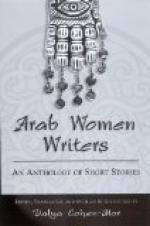It may be interesting to know whether present missionary experience differs from that of Mrs. Smith and her husband in 1835, with regard to children’s literature in the Arabic language.
In 1858, Mr. Ford prepared, with the aid of Mr. Bistany, (the husband of “Raheel,” Mrs. Smith’s adopted child,) a series of children’s Scripture Tracts in simple and yet perfectly correct Arabic, so that the youngest child can understand them. In 1862, we printed the first Children’s Hymn-book, partly at the expense of the girls in Rufka’s school. We have now in Arabic about eighty children’s hymns, and a large number of tracts and story books designed for children. We also publish an Illustrated Children’s Monthly, called the “Koukab es Subah,” “The Morning Star,” and the children read it with the greatest eagerness.
The Koran, which is the standard of classic Arabic, cannot be changed, and hence can never be a book for children. It cannot be a family book, or a women’s book. It cannot attract the minds of the young, with that charm which hangs around the exquisitely simple and beautiful narratives of the Old and New Testament. It is a gem of Arabic poetry, but like a gem, crystalline and unchanging. It has taken a mighty hold upon the Eastern world, because of its Oriental style and its eloquent assertion of the Divine Unity. It is reverenced, but not loved, and will stand where it is while the world moves on. Every reform in government, toleration and material improvement in the Turkish Empire, Persia and Egypt, is made in spite of the Koran and contrary to its spirit. The printing of the Koran is unlawful, but it is being printed. All pictures of living objects are unlawful, but the Sultan is photographed, Abd el Kader is photographed, the “Sheikh ul Islam” is photographed. European shoes are unlawful because sewed with a swine’s bristle, but Moslem Muftis strut about the streets in French gaiters, and the women of their harems tottle about in the most absurd of Parisian high-heeled slippers.
The Arabic Bible translated by Drs. Eli Smith and Cornelius Van Dyck, is voweled with the grammatical accuracy and beauty of the Koran with the aid of a learned Mohammedan Mufti, and yet has all the elegant simplicity of the original and is intelligible to every Arab, old and young, who is capable of reading at all. The stories of Joseph, Moses, and David, of Esther, Daniel and Jonah are as well adapted to the comprehension of children in the Arabic as in the English.
Not a few of the hymns in the Children’s Hymn book are original, written by M. Ibrahim Sarkis, husband of Miriam of Aleppo, and M. Asaad Shidoody, husband of Hada. This Hymn book was published in 1862, with Plates presented by Dr. Robinson’s Sabbath School of the First Presbyterian Church, Brooklyn.
This digression seemed necessary, in order to show the great progress that has been made since 1836, in preparing a religious literature. It is no longer true as in Mrs. Smith’s day, “that we have no psalms or hymns adapted to the capacities of children.” Nor is it longer true that “children’s literature is incompatible with the genius of the Arabic language.”




